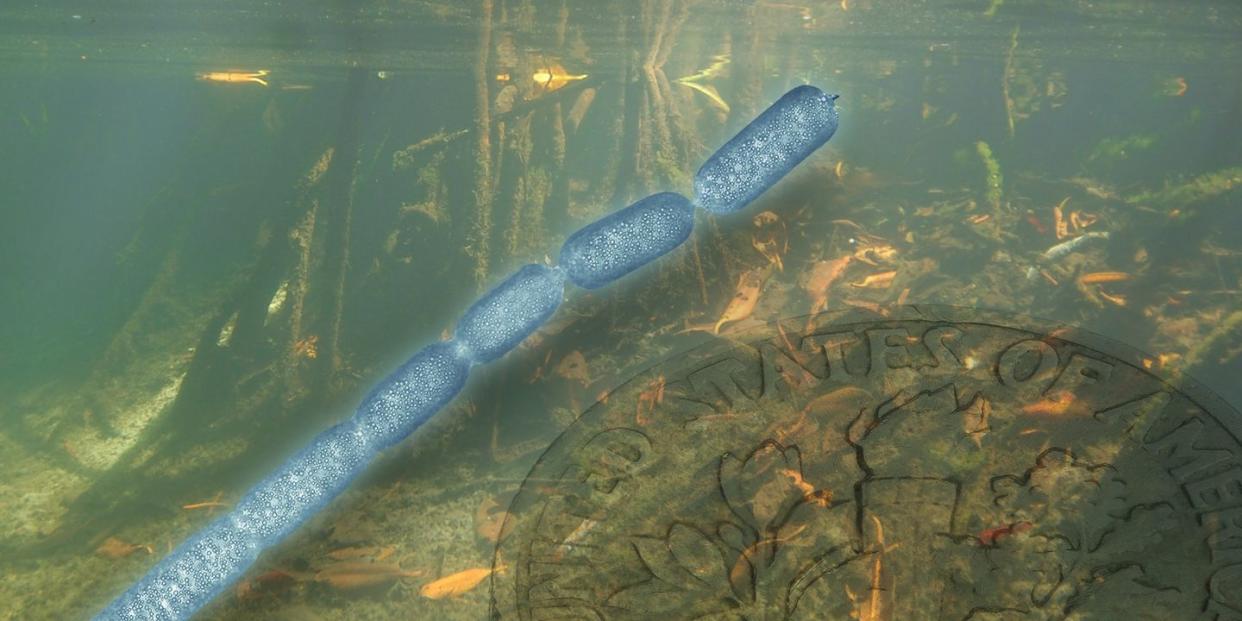This Eyelash-Sized Bacteria Is the Largest Ever Found

A bacterium first discovered in 2009 grows to over a centimeter long.
Its huge size and interior complexity both defy what we once knew about bacteria.
There are many known large, single-celled organisms, but before now, none were bacteria.
Scientists recently revealed a massive bacterium that’s large enough to see with the human eye. The size is staggering at almost a centimeter in length, but at the same time, it’s really no big deal in the world of huge, single-celled organisms.
The bacterium, Candidatus Thiomargarita magnifica, was found in the mangroves of the French Caribbean island of Guadeloupe. Mangroves are trees that grow in salty ocean water, tangling and forming pockets where little sub-ecosystems can form. The research comes from Lawrence Berkeley National Laboratory in California and was published last month in the journal Science.
The term “bacteria” is ubiquitous in daily life, from antibacterial ointment you put on a cut to antibiotics for an ear infection. You may have even read articles that your pet’s mouth is cleaner than a human’s (kind of an apples-and-oranges comparison) or that E. coli has been found on a certain grocery store’s fresh spinach. Bacteria are one of the evergreen perils of being a human, even while the world is experiencing a viral pandemic.
Bacteria are prokaryotes, a large biological group that also includes the category of archaebacteria. The single-cell prokaryotes don’t have cell organelles because they don’t have the internal structures to separate their materials, like the nucleus or the mitochondria. These stand in contrast to the eukaryotes, which do contain organelles. The archaebacteria are kind of a link between worlds, with some movements toward organization, but no official organelles.
🦠 Single-Celled Central
Like Living Batteries, These Bacteria Transform Methane Into Electricity
How Did Life Spring Up From Non-Life? Scientists May Finally Have Some Clues
These Hungry Metal-Eating Bacteria Could Be the Solution to Mining Waste
Because they are organizationally simpler than eukaryotes, prokaryotes are understood to have emerged sooner in Earth’s developmental history. And bacteria, in particular, are typically very tiny. “Cells of most bacterial species are around 2 micrometers in length,” the Berkeley Lab researchers explain. “Using fluorescence, x-ray, and electron microscopy in conjunction with genome sequencing, we characterized Candidatus (Ca.) Thiomargarita magnifica, a bacterium that has an average cell length greater than 9,000 micrometers and is visible to the naked eye.”
“To put it into context, it would be like a human encountering another human as tall as Mount Everest,” Jean-Marie Volland, a marine biologist who was involved in the new work, said in a statement. He has joint appointments with the Laboratory for Research in Complex Systems in California and the Lawrence Berkeley National Laboratory.

So yes, the astonishing size of the bacterium is, well, big news. “These cells grow orders of magnitude over theoretical limits for bacterial cell size,” the researchers explain, meaning it’s expanding our very idea of what a bacterium is and can be. And there’s more to it than meets the (naked) eye, because the huge size is paired with unprecedented cellular complexity. The bacterium has “half a million copies” of its genome, far more than almost any other known cell. Its interior is also marked by “bioenergetic membranes” that separate cell parts.
It’s surprising to find any bacterium that has grown this large and complex, which means we’ll likely see plenty of new research on this same species. But it’s not surprising for a single cell to grow this large. AllTheScience explains some of the other largest ones. Ostrich eggs, for instance, grow up to about six inches long and weigh about three pounds. Nerve cells of the giant squid can reach up to 39 feet long. And in terms of standalone single-celled organisms, some algae can grow into spheres that are fully centimeters in diameter.
You Might Also Like


